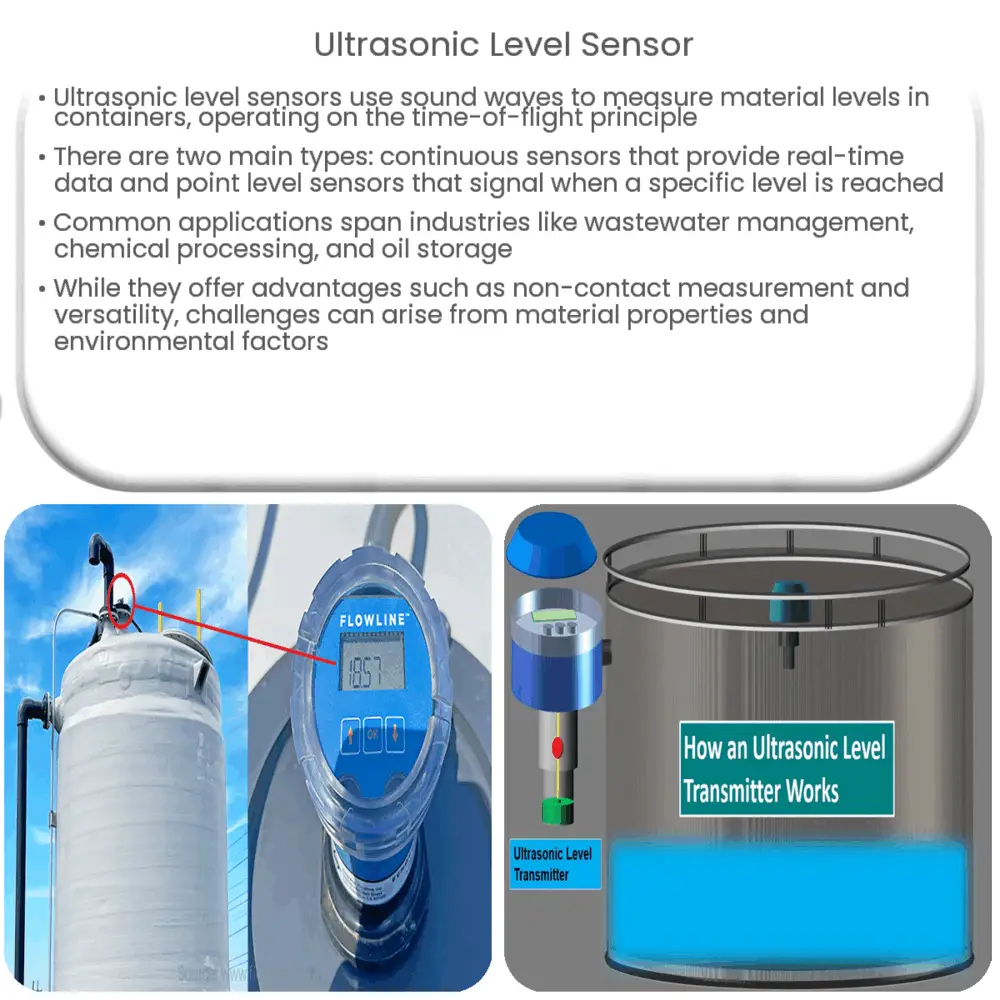Ultrasonic level sensors use high-frequency sound waves to measure material levels in containers, offering accuracy, versatility, and non-contact measurement.

Ultrasonic Level Sensor: A Comprehensive Overview
An ultrasonic level sensor is a device that uses sound waves to measure the distance or level of a material in a container or tank. The sensor emits high-frequency ultrasonic waves and measures the time it takes for the waves to bounce back after hitting the target object. This time delay is then used to calculate the distance or level of the material. In this article, we will delve into the working principles, applications, and benefits of ultrasonic level sensors.
How Ultrasonic Level Sensors Work
Ultrasonic level sensors operate using the principle of time-of-flight measurement. A transducer, which is a part of the sensor, generates ultrasonic waves with frequencies typically ranging from 20 kHz to several MHz. These sound waves travel through the air and hit the target object, such as the surface of a liquid, solid, or granular material. The waves then reflect back towards the transducer, where they are received and processed.
The time it takes for the waves to travel to the object and back is directly proportional to the distance between the transducer and the object. By measuring this time delay, the sensor can accurately calculate the distance or level of the material. The following formula is used to determine the distance:
Distance = (Speed of Sound × Time Delay) / 2The division by 2 is necessary because the time delay measures the round-trip time, i.e., the time it takes for the sound waves to travel to the target and back to the sensor. The speed of sound in air is approximately 343 meters per second, but this value can vary depending on factors such as air temperature, pressure, and humidity. Ultrasonic level sensors typically account for these variations to ensure accurate measurements.
Types of Ultrasonic Level Sensors
There are two primary types of ultrasonic level sensors: continuous and point level sensors. Continuous level sensors measure the level of the material in real-time and provide a continuous output signal proportional to the distance or level. This type of sensor is ideal for applications requiring continuous monitoring and control of liquid or solid levels.
Point level sensors, on the other hand, only detect when the material reaches a predetermined level. They act as a switch, sending a signal when the level reaches a specific set point. Point level sensors are commonly used for overfill protection, low-level alarms, or pump control applications.
Applications of Ultrasonic Level Sensors
Ultrasonic level sensors are versatile devices with a wide range of applications across various industries. Some of the most common uses include:
- Water and wastewater management
- Chemical processing and storage
- Food and beverage production
- Oil and gas storage and distribution
- Pharmaceutical manufacturing
- Mining and aggregates
Benefits of Ultrasonic Level Sensors
Ultrasonic level sensors offer several advantages over other level measurement technologies, such as float switches, capacitance, and radar sensors. These benefits include:
- Non-contact measurement: Ultrasonic sensors do not require contact with the target material, which helps prevent contamination and wear-and-tear on the sensor. This non-invasive nature makes them ideal for use with corrosive, viscous, or abrasive materials.
- Accurate and reliable: Ultrasonic level sensors provide high accuracy and repeatability, even in challenging environments with turbulence, foam, or vapor. Advanced signal processing techniques and temperature compensation help to ensure consistent, reliable measurements.
- Easy installation and maintenance: These sensors can be easily installed on the exterior of a tank or container without the need for drilling or modifications. Furthermore, the lack of moving parts reduces the need for regular maintenance and lowers the overall cost of ownership.
- Versatility: Ultrasonic level sensors can be used with various materials, including liquids, solids, and granular materials. They can also be easily configured to work in a wide range of applications and industries.
Limitations and Considerations
While ultrasonic level sensors offer numerous advantages, they also have certain limitations and considerations that should be taken into account when selecting a level measurement solution:
- Material properties: The speed of sound varies in different materials, which can affect the accuracy of the sensor. In some cases, the material’s properties may cause excessive attenuation or absorption of the sound waves, leading to poor or no signal return.
- Environmental factors: Factors such as extreme temperatures, high humidity, or excessive dust can impact the performance of ultrasonic level sensors. In such cases, additional precautions or alternative sensor technologies may be necessary.
- Foam or heavy vapors: While ultrasonic sensors can perform well in the presence of foam or vapors, heavy concentrations can cause signal attenuation and compromise the accuracy of the measurement. It is essential to assess the specific application conditions to determine if an ultrasonic sensor is appropriate.
Conclusion
Ultrasonic level sensors provide a versatile, accurate, and reliable solution for various level measurement applications across numerous industries. Their non-contact nature, ease of installation, and low maintenance requirements make them an attractive choice for many users. However, it is essential to consider the specific application requirements and limitations of the technology to ensure the best possible performance and long-term success.

